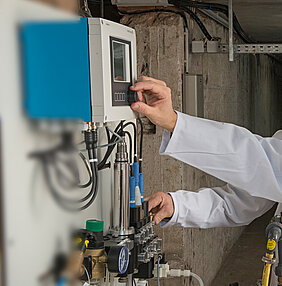Efficient monitoring of drinking water treatment processes using online measurement technology is becoming increasingly important, partly due to new regulations. The aim of the DVGW research project TRINKcontrol was to investigate innovative applications of online measurement technology, e.g. for automatic process control and further microbiological quality monitoring, and to develop recommendations for practical use.
An initial literature research recorded the scientific and practical state of knowledge on online analysis methods and also their possible developments. Special consideration was given to AI-supported evaluations of online measurement data with the aim of using them for automatic process control. On the one hand, new types or alternative concepts of/for sensors were identified as drivers for new developments. On the other hand, increasing digitalization will have a major impact on data management in the future.
In a survey of water suppliers, the current status of 40 waterworks in Germany and neighbouring countries with regard to online measurement technology were analysed. It was found, that in addition to the standard online parameters used in almost all plants, such as pH value and electrical conductivity, additional online measuring devices, e.g. particle measurement using laser shading or fluorescence/SAK254 measurement, are often used for more complex surface water treatment. According the specifications of the water supply companies, there is a need for development with regard to operationally stable, low-maintenance sensor technology and, in particular, the online recording of microbiological parameters.
The latter, i.e. the online recording of microbiological parameters, was already a central work package of the TrinkControl project. Three devices with the online-capable microbial parameters adenosine triphosphate, enzyme activity and cell count were used. All three measurement methods and devices proved to be suitable for practical use. They are stable in operation, have sufficiently high sensitivities and can be used in addition to the periodic culture procedures to quickly detect changes in the microbiological water quality.
Another focus of the TrinkControl project was the automatic control of flocculation processes (e. g. within inline and direct filtration) in the treatment of surface water. For this purpose, long term experiences with such control processes in several waterworks were initially evaluated. This was the basis for the development of a measuring and dosing technology, which was installed in a spring water plant with strongly fluctuating raw water quality and tested and optimized over several months. As a result, a generally applicable recommendation for the implementation of an automatic flocculent addition control system was elaborated.
Based on the experience with AI-based process control (work package 5) it can be concluded that it can be used to optimize drinking water treatment processes.

![[Translate to English:] Prüfstelle-Produktprüfung_Teststand Test centre and product testing](/fileadmin/_processed_/0/9/csm_TZW-Karlsruhe_Pruefung_Geraete-Teststand_377188946c.jpg)

























